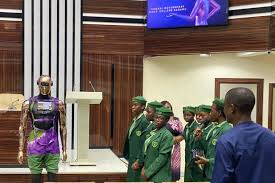The Federal Government Girls’ College (FGGC) Sagamu, Ogun State, Nigeria, has created the Okikiola-Sagamu, also referred to as Kiki-Saggy, AI robot.
David Adejo Andrew, the Permanent Secretary of the Federal Ministry of Education, saw the project for the first time in Abuja.
Ten students and a few staff members worked on it.
The members of the robotics team claimed in an interview that they were chosen from both the senior and junior classes. They talked about the robot and said that it is 6 feet tall, weighs 60kg, and can go as fast as 10 kilometers per hour.
“The AI robot project took about seven months, and Kiki-Saggy can talk, walk, and even make hand gestures,” they said.
Read also: Google unveils new Robotic Transformer 2, RT-2 mode
When asked about the building process of Kiki, the creators said that they were able to use artificial intelligence and machine learning to build the robot. They said that Okiki-Saggy was their first “successful trial,” even though there had been other trials before this one. Most of the robots that came before Kiki were not able to get to the final step like Kiki did.
Additionally, they claimed that Coderina.org, a nonprofit organization that develops people’s skills and uses robotics and other cutting-edge technology to empower children and educators in Africa, was a major contributor to their success. They also praised their teachers, notably Dr. Muyibat Adenike Olodo, the school director and robotics team leader.
Dr. Olodo discussed how technology is creating new ideas and a better future during the event. She added that future areas will let students demonstrate their creativity, problem-solving skills, and technical skills.
The current Kiki-Saggy is merely the start. The FGGC robotics team plans a better, more advanced version. Discussing how the next edition could improve. Dr. Mrs. Olodo demonstrated that innovation is ongoing. She also proved that some college courses mold young students’ ideas and equip them to succeed in a world of cutting-edge technology.
Developing Kiki-Saggy
It can be hard to figure out how an AI robot is made and how it works. The FGGC Robotics team had to find a good balance between how the robot looked and how well it worked. On the way to making Kiki-Saggy, the builders had to deal with these problems.
The team had to deal with technical problems, complicated code, money problems, hardware problems, drilling holes, and even putting together different parts. But getting through these problems led to important lessons and satisfying results.
But they got some help to finish the job, such as from a woman named Madam Lisa in the United States.
The robotics team at FGGC Sagamu hopes that the Ministry of Education will help and push the team so that they can make a better version of Kiki Saggy.
Future technology will involve AI robots.
There has been clear progress in robot technology. From smarter sensors and actuators to better programmes for artificial intelligence, robots are getting smarter, more capable, more flexible, and more user-friendly. They can now get around in complicated places, do delicate jobs with care, and even learn from what they do.
Collaborative robots, also called cobots, are becoming more popular because they can work with people. This makes them more productive and safer in many industries. Robotic study and development are still going on, so the future of robotic technology looks good.
In healthcare, robots are used for things like surgery, taking care of patients, and helping them get better. They can help doctors do exact surgeries, give medicines, and help patients who have trouble moving around. Robots could also help with the lack of doctors and nurses, especially in places that are hard to reach.
Robots are extremely useful for space exploration because they can complete tasks in challenging and hazardous environments. They can travel to other worlds, gather information, and perform perilous tasks humans can’t. The Mars rovers have taught us about nearby planets.
Future human-robot collaboration is promising. Robots are learning human emotions. This will make them smarter and better at personal assistance. This fosters camaraderie, care, and community well-being.
Robotics technology is changing these fields, and it’s crucial to consider how robots can aid healthcare, space exploration, and daily life.














